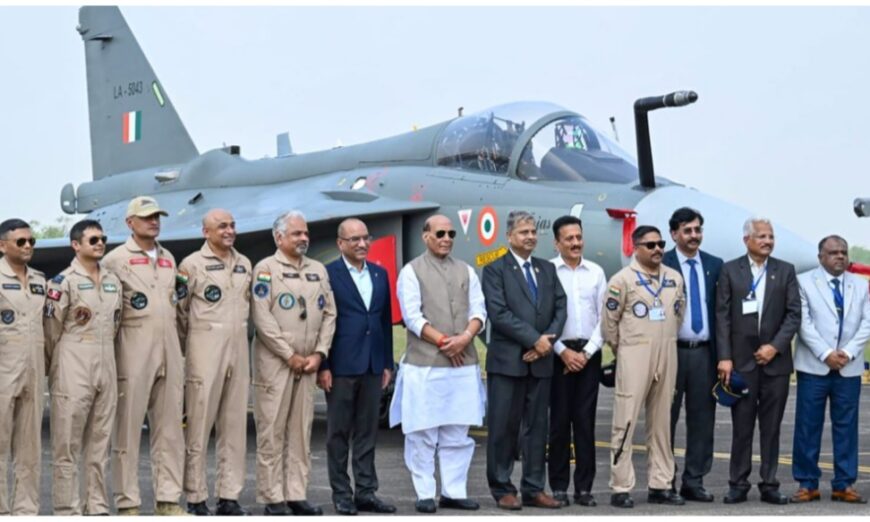Defence Minister Rajnath Singh on Friday inaugurated the third production line of the HAL Tejas Mk1A Light Combat Aircraft and the second production line of the HAL HTT-40 trainer aircraft at the Nashik facility of Hindustan Aeronautics Limited (HAL). He also flagged off the first Tejas Mk1A manufactured at the new line, hailing it as a major step toward strengthening India’s defence manufacturing capabilities.
Speaking at the event, Singh described the successful flight of the state-of-the-art Tejas Mk1A as a “shining symbol of India’s growing Aatmanirbharta in defence.” He recalled that when the current government came to power in 2014, India was importing nearly 70% of its critical military hardware. Over the past decade, he said, this dependency has been significantly reduced, with 65% of the required equipment now manufactured domestically.
“When we came to power, we faced limited defence preparedness, high import dependency, and minimal private sector participation. Today, we are building at home what we once imported—fighter aircraft, missiles, engines, and electronic warfare systems,” Singh said, stressing that the government aims to make India fully self-reliant in defence production.
He highlighted the rapid expansion of the sector, with annual defence production rising from ₹46,429 crore in 2014–15 to over ₹1.5 lakh crore in 2024–25, while defence exports have soared to ₹25,000 crore from less than ₹1,000 crore a decade ago. The government has now set a target of achieving ₹3 lakh crore in defence manufacturing and ₹50,000 crore in exports by 2029.
Pointing to the changing nature of warfare, Singh emphasised the need to stay ahead in domains such as artificial intelligence, cyber warfare, drone systems, and next-generation aircraft. He called on HAL to expand its technological footprint beyond Tejas and HTT-40, positioning itself as a global player in advanced aviation and unmanned systems.
The minister lauded HAL’s contribution to strengthening India’s defence ecosystem, calling it the “backbone of the defence sector.” He highlighted its crucial role during Operation Sindoor, when the Nashik team integrated the BrahMos missile on the Sukhoi Su-30MKI, enabling precision strikes on terrorist hideouts.
Singh also praised the Nashik division for its legacy of over six decades, during which it has manufactured and overhauled aircraft such as Mikoyan-Gurevich MiG-21 and Mikoyan MiG-27, and evolved into a major production hub for Su-30 fighter jets.
Secretary (Defence Production) Sanjeev Kumar said the inauguration of the two new production lines reflects India’s growing technological confidence and strategic foresight. He described Tejas Mk1A as “a statement of India’s design and manufacturing excellence,” developed indigenously through collaboration between HAL, Aeronautical Development Agency, Defence Research and Development Organisation and Indian Air Force.
HAL CMD DK Sunil called the operationalisation of the new production lines a testament to HAL’s expanding capacity. The project is expected to generate around 1,000 jobs and foster partnerships with more than 40 industry players in and around Nashik.
The inaugural Tejas Mk1A sortie was piloted by HAL Chief Test Pilot (Fixed Wing) KK Venugopal (Retd), followed by aerial displays by Su-30MKI and HTT-40 aircraft, with the Tejas receiving a ceremonial water cannon salute.
The new Tejas Mk1A production line was operationalised in just two years and can manufacture eight aircraft annually, increasing HAL’s total capacity to 24 Tejas jets per year. Meanwhile, the second HTT-40 production line will support the assembly of key components including fuselages, wings and control surfaces.
Established in 1964, HAL Nashik has produced more than 900 aircraft and overhauled 1,900, making it one of India’s most significant aerospace facilities. The division continues to provide full lifecycle support for Su-30MKI aircraft and plays a pivotal role in advancing the country’s defence manufacturing ambitions.

